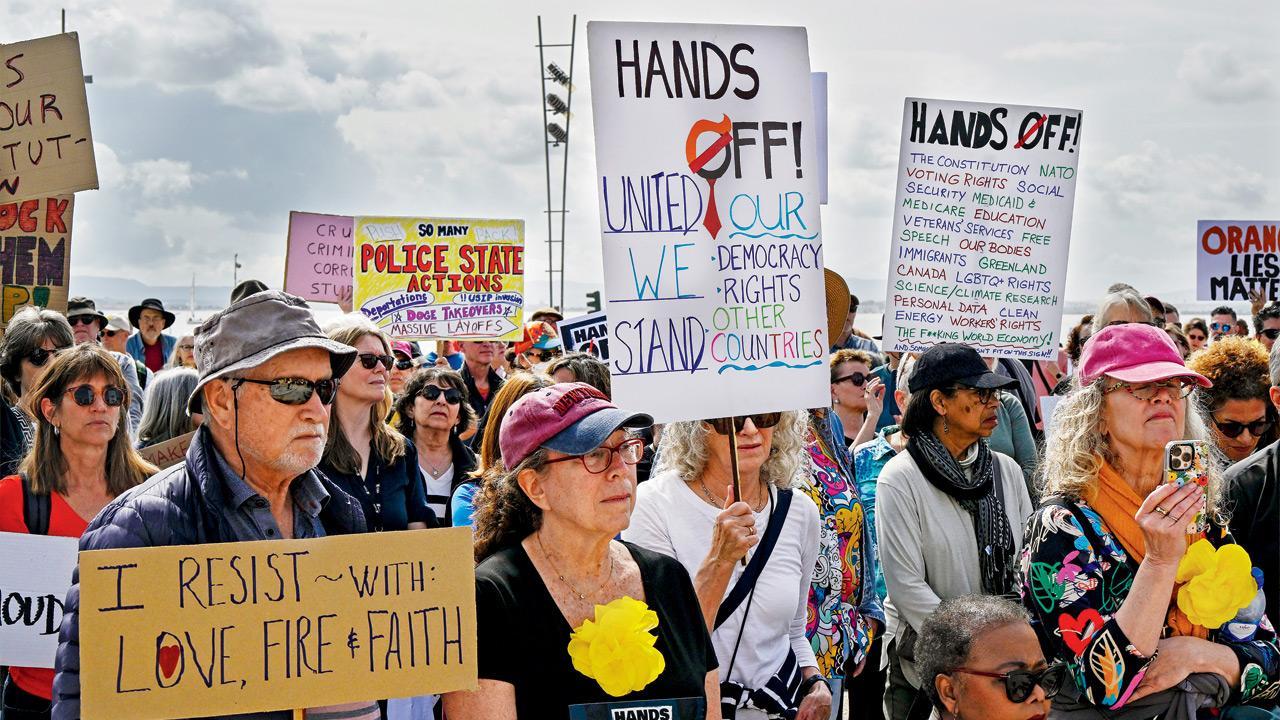Over 1200 demonstrations have been planned to protest government downsizing and human rights violations

Protesters are taking to the streets to protest the Trump administration in all 50 US states and internationally including countries like the US, Portugal, and Germany. Pic/Getty Images
Opponents of President Donald Trump and billionaire Elon Musk have started to rally across the US on Saturday to protest the administration’s actions on government downsizing, the economy, human rights and other issues.
ADVERTISEMENT
More than 1200 “Hands Off!” demonstrations have been planned by more than 150 groups, including civil rights organisations, labour unions, LBGTQ+ advocates, veterans and fair-elections activists. The protests are planned for the National Mall in Washington, DC, state capitals and other locations in all 50 states.
The White House did not return an email seeking comment about the protests. Trump has promoted his policies as being in the best interest of the US. Protesters are assailing the Trump administration’s moves to fire thousands of federal workers, close Social Security Administration field offices, effectively shutter entire agencies, deport immigrants, scale back protections for transgender people and cut federal funding for health programmes.

Activists have staged nationwide demonstrations against Trump or Musk multiple times since the new administration took power. But the opposition movement has yet to produce a mass mobilisation like the Black Lives Matter demonstrations that erupted in multiple cities after George Floyd’s killing in 2020.
American farmers fear tariffs could cost them biggest markets in China
Heading into this year, most US farmers were hoping to break even or maybe record a small profit if they could find a way to limit their sky-high costs. But now they are faced with losing the biggest export market for many of their crops after China retaliated against President Donald Trump’s tariffs. “There’s just not any margin for error in the current farm economy,” said Kentucky farmer Caleb Ragland, who serves as president of the American Soybean Association.

Washington DC State Board of Education representative spoke during the rally
China has bought a lot of soybean, American corn, beef, chicken and other crops as part of spending $24.65 billion on US agricultural products last year. Now with China slapping 34 per cent tariffs on all American products—on top of other tariffs it imposed earlier this year—all of those products will be significantly more expensive in China. One of the biggest long-term concerns is that American farmers and ranchers will lose market share as China turns to Brazil and other countries to buy goods.
Pakistan sees US tariffs as a chance for new negotiations
Pakistan’s Finance Minister Muhammad Aurangzeb said that the country is to set up two committees to tackle the economic implication of the new tariffs imposed by US. “You should never let a good crisis go to waste,” he said, explaining that while the situation created challenges, it also would open doors for negotiation in the future.
Iran’s rial falls to a record low
Iran’s rial currency traded on Saturday at a record low against the US dollar as the country returned to work after a long holiday, costing over 1 million rials for a single greenback as tensions between Tehran and Washington likely will push it even lower. The exchange rate had plunged to over 1 million rials during the Persian New Year, Nowruz, as currency shops closed, creating additional pressure on the market. But as traders resumed work on Saturday, the rate fell even further to 1,043,000 to the dollar.
This story has been sourced from a third party syndicated feed, agencies. Mid-day accepts no responsibility or liability for its dependability, trustworthiness, reliability and data of the text. Mid-day management/mid-day.com reserves the sole right to alter, delete or remove (without notice) the content in its absolute discretion for any reason whatsoever
 Subscribe today by clicking the link and stay updated with the latest news!" Click here!
Subscribe today by clicking the link and stay updated with the latest news!" Click here!







